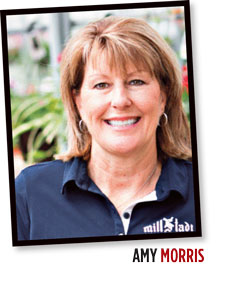6/1/2022
The Upside of Learning & Reviewing
Amy Morris

“Don’t count your chickens until they’re hatched” is a common, old-time phrase that’s telling us not to make assumptions. For the past two years, we’ve lived the glory days of selling plants, and anything we could get our hands on, we planted and sold. We’ve spoken with many other growers who’ve experienced the same and hope that this trend would stay as the new norm. But has it?
As a grower, we know a late Easter always brings a late spring, but Mother Nature hasn’t done us any favors this year. It seems the occurrence of bad weather has been constant across the U.S. for 2022. Late frost, rain and lack of sunshine has put our shipping on hold. As I write this, we’re one week from Mother’s Day and still waiting to get our first turn out the door. We have no space to keep planting or space for planters that should have already gone to market. On top of that, we now need to look at future planting, and decide what needs to be discarded instead of transplanting because it’s much cheaper to purge in the plug stage than plant into a finished pot. Since the cost of labor is so high, we need to look at the company health as a whole and start making some hard decisions.
COVID (I was trying not to bring it up, but for this part, I needed to) brought us sales numbers that we haven’t seen in a long time. Across the country, seasonal garden centers had to close their doors early because they were sold out and greenhouses were seeing up to three full turns. I bring this up since it happened two years in a row. We were hoping this would continue to repeat itself, but the weather didn’t cooperate with any of us.
So, the question is, how do we make spring work for next year? As I reflect back on all of this, here’s what I’ve learned throughout the years.
First, take a long, hard look at your sales plan. Compile data not in just the last two years, but go back five-plus years. We always try to be a one-stop-shop—everything for everybody—and with the cost of inputs so high, we need to focus on our core sales and perhaps leave some of the fluff off our offering.
One of the first things we need to take a hard look at is our speculation. Is it good for the company to bank on sales items that aren’t sold? The last two years I would tell you absolutely, but for this current year, not at all. I’m also not saying to stop producing extra plants for market—just review it closer and look at spring pre-pandemic.
Second, once your plan is in place, make sure you review with your grower or staff who’ll be taking care of the crops. Remember your money is now in their hands, so make sure you’re clear on how you want the crops managed in good or bad weather. Taking the extra time early to review for how to push a crop or hold it can save you a lot of headaches.
Third, look at your “laydown plan.” Putting similar plants together in the same zone can cut expenses. Planning and placement of pansies, petunias and calibrachoa together can result in a section with lower temperatures, lower feed and pH versus keeping your warm weather, higher-feeding plants together. This way you can keep your heat and fertilizer bills down as best as possible.
I know this all sounds very basic, but I know I’ve been a little lazy about doing these reviews myself. When you have two years in a row where no matter what you produced sold, you tend to get a bit complacent and stop focusing on what’s important.
We all need to look back with a renewed focus on the basics and a new definition of what the fundamentals should look like. Making a spring plan and sticking with it. Producing what you can with the space you have. Crowding early is fine, as long as you space it out before shipping starts and room opens up. Watch the weather and make sure you’re pushing or holding in the correct manner. Take the time to review with your staff. Give them your vision and your plans for the company. Make them more invested in the company success and make sure they realize the better the health of the company is, the better it is for all.
I’m sure each of you could find many other examples of things we overlook due to spring’s slow arrival, but I really think this is the best time to analyze your work processes and practices, and make improvements. There’s no bigger payout than efficiency improvement in spring, so take the time needed to invest in a renewed focus. GT
Amy Morris is Vice President of N.G. Heimos Greenhouses in Millstadt, Illinois. She can be reached at Amorris@ngheimos.com.